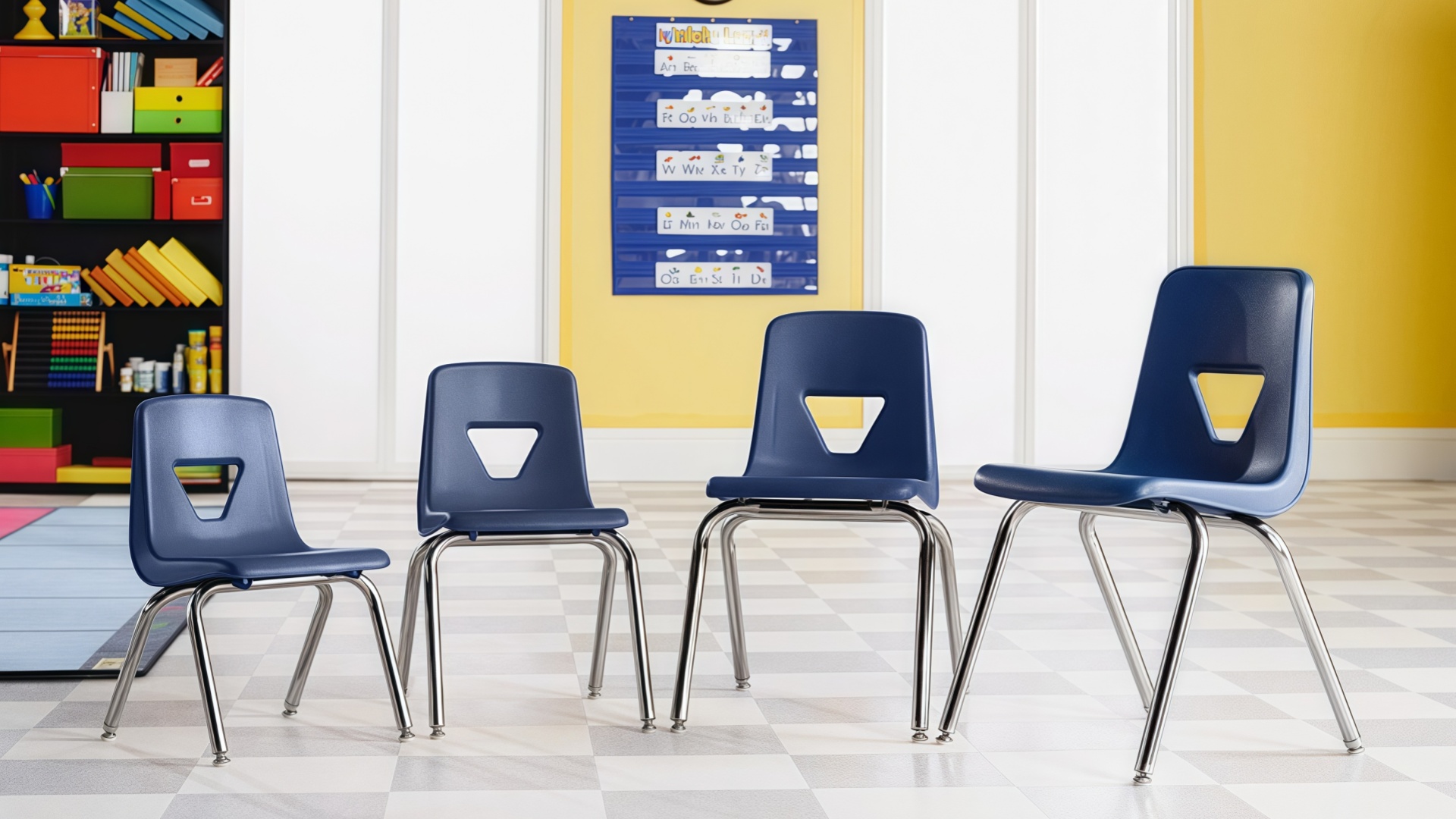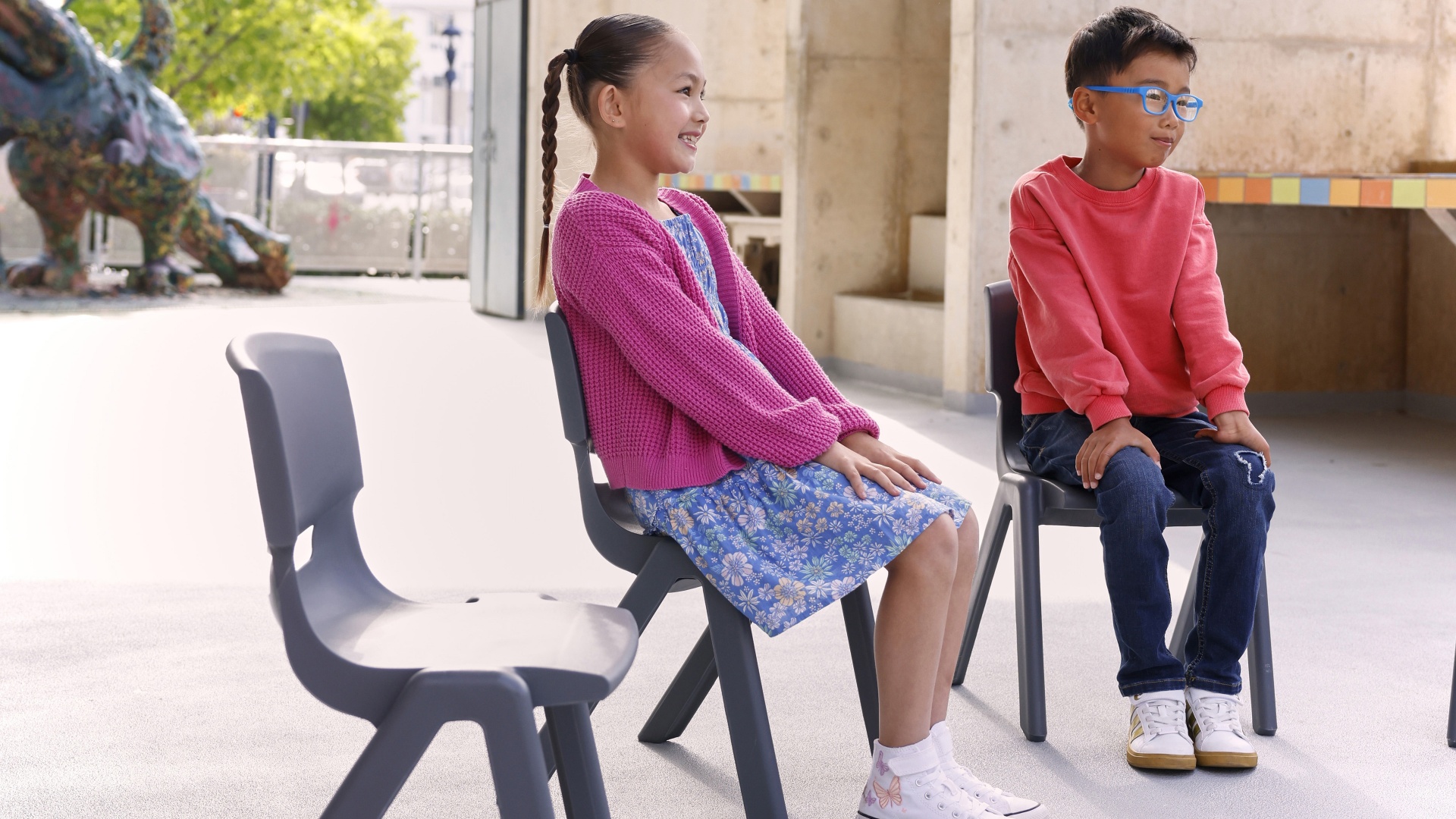Views: 0 Author: Site Editor Publish Time: 2025-10-16 Origin: Site











In today's fast-evolving educational landscape, flexibility and adaptability have become essential components of modern learning environments. Schools, colleges, and training centers are no longer designed around rigid classroom layouts or single-purpose furniture. Instead, they are embracing multifunctional spaces that support collaboration, creativity, and active learning.

At the heart of this transformation lies the concept of furniture mobility—and among all furniture types, stackable chairs stand out as a simple yet powerful solution. These chairs combine practicality, versatility, and aesthetic appeal, allowing educators to quickly reconfigure classrooms and communal spaces to match the needs of different activities throughout the day.
From a morning lecture to an afternoon workshop, from a group project to an evening performance, stackable chairs enable seamless transitions between learning modes. More importantly, they help schools make efficient use of limited space—a critical consideration for urban campuses and institutions that host multiple programs in the same facility.
In this guide, we’ll explore the design, functionality, and numerous advantages of stackable chairs in educational settings. You’ll discover why they’re a cornerstone of modern school furniture design, what features to look for when choosing them, and how they can elevate the comfort, efficiency, and visual harmony of multifunctional school spaces.
Stackable chairs are seating units specifically engineered to be placed one on top of another without damage or deformation. This feature allows schools to store multiple chairs compactly when not in use, freeing up valuable floor area for other functions such as sports, performances, or exhibitions.

Traditional school chairs were often bulky, heavy, and fixed in place—designed for a single purpose: classroom learning. As education models evolved toward active learning and flexible layouts, schools required furniture that could adapt to changing needs. Stackable chairs emerged as a smart response, offering both portability and efficiency.
Today's stackable school chairs are available in a wide range of styles—from minimalist polypropylene shells with chrome legs to fully upholstered ergonomic designs. Many models can be stacked between 6 to 10 chairs high, depending on the frame structure and material, without compromising stability.
Modern stackable chairs are made from materials chosen for durability, lightness, and safety:
Polypropylene (PP): Lightweight, easy to clean, and available in multiple colors—ideal for classrooms and cafeterias.
Polycarbonate: Offers higher impact resistance and transparency for contemporary designs.
Metal (Steel or Aluminum Frames): Adds structural strength while maintaining a sleek look.
Wood or Veneer: Provides warmth and aesthetic charm for libraries or lecture halls.
Each material has its advantages depending on the setting—polypropylene for mobility and affordability, wood for sophistication, and metal for robustness. When combined with thoughtful ergonomic design, these materials ensure that stackable chairs meet the functional and aesthetic standards of modern education spaces.
In the past, schools were built with static layouts: classrooms lined with rows of desks facing a single teaching wall. However, 21st-century education emphasizes collaboration, problem-solving, and active engagement. This shift demands learning environments that are as dynamic as the students who occupy them.
Multifunctional school spaces are designed to serve multiple purposes—lecture, discussion, art, recreation, or group work—within the same area. A classroom can double as a seminar room, a cafeteria can transform into an event hall, and a library can accommodate both quiet reading and teamwork sessions.
For such flexibility to work, the furniture itself must be adaptable. Stackable chairs make this possible by allowing quick reconfiguration: students or staff can clear or rearrange seating within minutes, with minimal physical effort.
Research shows that flexible furniture arrangements encourage collaboration and participation. When students can easily move their chairs into circles, clusters, or open spaces, communication becomes more fluid, and creativity flourishes. Stackable chairs facilitate these movements—lightweight enough for students to handle, yet sturdy enough to ensure comfort during long sessions.
Moreover, multifunctional spaces help educators experiment with diverse teaching methods—lectures, group discussions, project-based learning, and peer tutoring—all supported by the same physical environment. Stackable chairs thus become essential tools for fostering an adaptive learning culture.
Consider a modern secondary school that uses its main hall for different purposes throughout the day. In the morning, it hosts assemblies; in the afternoon, it transforms into a dining area; and in the evening, it accommodates community workshops. With stackable chairs, transitions between these functions are effortless. After each event, the chairs can be stacked on trolleys and stored neatly, freeing space for the next activity.
This adaptability not only saves space but also reduces the need for multiple types of furniture—making stackable chairs a cost-efficient and space-saving investment for educational institutions.
Stackable school chairs are not only space-saving but also designed with student comfort and posture in mind. Their ergonomic contours help maintain correct spinal alignment during long learning sessions, promoting both focus and physical well-being.
High-traffic school environments require furniture that can withstand years of use. Most stackable chairs feature metal or polypropylene frames, offering excellent durability, while their easy-clean surfaces make them ideal for classrooms, cafeterias, and labs.
| Material | Durability | Comfort Level | Maintenance | Common Use Areas |
|---|---|---|---|---|
| Polypropylene (PP) | High | Medium | Easy | Classrooms, dining halls |
| Metal (Steel/Aluminum) | Very High | Medium-High | Moderate | Laboratories, assembly halls |
| Wood | Medium | High | Moderate | Libraries, art rooms |
| Upholstered Fabric | Low-Medium | Very High | Moderate-High | Lecture halls, offices |
Stackable designs allow schools to maximize floor space for multipurpose use. Chairs can often be stacked 8–12 high and moved using trolleys or dollies, streamlining the process of setting up or storing furniture.

Modern classrooms require flexible layouts for group learning, lectures, and workshops. Stackable chairs provide quick reconfiguration—teachers can easily clear or rearrange space for activities.

In libraries, stackable chairs help balance quiet study zones with flexible furniture arrangements for group discussions or digital resource use.

Large spaces such as auditoriums and dining halls benefit the most from stackable chairs. Schools can switch from a cafeteria layout to a seminar setup within minutes.
Comparison of Stackable Chair Use in Different School Spaces
| School Area | Primary Need | Best Chair Type | Stack Height | Recommended Material |
|---|---|---|---|---|
| Classroom | Flexibility, comfort | Ergonomic plastic chairs | 8–10 | Polypropylene |
| Library | Quiet, comfort, aesthetics | Wooden or cushioned chairs | 6–8 | Wood/Fabric mix |
| Cafeteria | Durability, hygiene | Lightweight metal chairs | 10–12 | Metal/PP hybrid |
| Assembly Hall | Large capacity, storage | Slim stackable chairs | 12+ | Steel/aluminum |
| Staff Room | Comfort, professional look | Upholstered stackable chairs | 5–6 | Fabric + Metal frame |
Schools serving multiple age ranges—from primary to secondary—should select stackable chairs proportionate to students' height and posture needs.
| Age Group | Seat Height (mm) | Seat Width (mm) | Seat Depth (mm) | Backrest Height (mm) |
|---|---|---|---|---|
| 3–6 years (Preschool) | 260–300 | 280–320 | 260–300 | 250–300 |
| 7–10 years (Primary) | 340–380 | 320–360 | 320–360 | 300–350 |
| 11–14 years (Middle) | 400–440 | 360–400 | 360–400 | 350–400 |
| 15+ years (Secondary/College) | 450–480 | 400–440 | 400–450 | 400–450 |
Safety features such as anti-tilt legs, non-slip foot caps, and reinforced joints are essential to prevent accidents. Rounded edges further enhance safety for younger students.
Modern school furniture design integrates color psychology and branding—using school colors to build a cohesive visual identity while maintaining function.

In modern education design, sustainability plays a central role. Schools are increasingly adopting eco-conscious furniture to align with green building certifications like LEED or BREEAM. Stackable chairs contribute to sustainability in several ways:
Recyclable materials: Most are made from polypropylene, aluminum, or steel — all recyclable and reusable.
Low-VOC finishes: Environmentally safe coatings ensure better indoor air quality.
Longevity: Durable frames reduce the frequency of replacement, minimizing waste.
Manufacturers that follow ISO 14001 environmental standards or use closed-loop production systems reduce their carbon footprint significantly. Educational institutions can prioritize suppliers that:
Source responsibly harvested wood
Use energy-efficient production lines
Minimize packaging waste
Implement take-back or recycling programs for end-of-life furniture
Though sustainable furniture might cost slightly more upfront, it leads to lower lifecycle costs due to longer use and reduced maintenance needs. For public schools and universities managing large budgets, this approach ensures both environmental and financial sustainability.
1. Identify Usage Scenarios – Determine where the chairs will be used most frequently (e.g., classrooms, cafeterias, halls).
2. Measure Available Space – Consider stack height and storage area dimensions.
3. Check Ergonomic Fit – Match chair sizes to student age groups for comfort and posture support.
4. Assess Durability Requirements – Choose sturdy materials for high-traffic areas.
5. Review Safety Standards – Look for BIFMA, EN1729, or ANSI-certified furniture.
6. Evaluate Supplier Credibility – Partner with experienced manufacturers who provide customization, after-sales service, and project support.
| Chair Type | Average Unit Price (USD) | Expected Lifespan (Years) | Maintenance Level | Overall Value Rating |
|---|---|---|---|---|
| Polypropylene Stackable Chair | $25–$45 | 8–10 | Low | ★★★★☆ |
| Metal Frame Chair | $40–$70 | 10–15 | Low–Medium | ★★★★★ |
| Upholstered Stackable Chair | $60–$90 | 6–8 | Medium–High | ★★★☆☆ |
| Wooden Stackable Chair | $55–$80 | 8–12 | Medium | ★★★★☆ |
Tip: For large-scale school projects, bulk purchasing directly from manufacturers (like Hongye Furniture) can reduce costs by 15–25%, while ensuring design consistency across different school spaces.
Schools today seek not only functional but brand-consistent furniture. Customization options may include:
Color matching to school identity
Logo embossing or engraving
Adjustable seat heights for multi-age classrooms
Optional upholstery or padding for comfort in lecture halls
Manufacturers specializing in educational projects can also provide 3D layout design and space planning support — ensuring stackable chairs integrate seamlessly into the school's architectural vision.
Stackable chairs are far more than a practical solution for space-saving. They embody the principles of flexibility, comfort, and efficiency that modern education demands.
For multifunctional school environments — from classrooms to auditoriums — these chairs enable adaptive layouts, quick reconfiguration, and long-term value.
Schools that prioritize ergonomics, safety, and sustainability not only enhance student well-being but also future-proof their learning environments against changing educational models.
Whether you're a school planner, architect, or procurement officer, stackable chairs represent an investment in both space optimization and student experience — blending durability with modern design.
Q1: How many stackable chairs can be safely stacked together?
Most school-grade stackable chairs can be safely stacked 8–12 units high, depending on material and design. Always follow manufacturer recommendations.
Q2: Are stackable chairs suitable for outdoor use?
Yes. Many polypropylene or metal-framed chairs are weather-resistant and can be used outdoors for school events or sports days.
Q3: What’s the best material for long-term use in schools?
Metal-framed polypropylene is ideal — it’s durable, easy to clean, and maintains structural integrity even after years of use.
Q4: How do stackable chairs support ergonomic posture?
Their contoured backrests and proper seat angles promote healthy sitting postures, reducing fatigue and improving focus among students.
Q5: Can stackable chairs be customized for different age groups?
Absolutely. Leading school furniture suppliers offer multiple seat heights and widths, suitable for preschool, primary, and secondary education settings.
Q6: How do stackable chairs contribute to sustainable school design?
By using recyclable materials and energy-efficient production, they align with green school initiatives and reduce long-term waste.
Looking to furnish your school with smart, flexible seating solutions?
Hongye Furniture Group offers customizable, durable, and ergonomic stackable school chairs designed for modern learning environments.
Contact us today to get your free classroom layout design proposal.